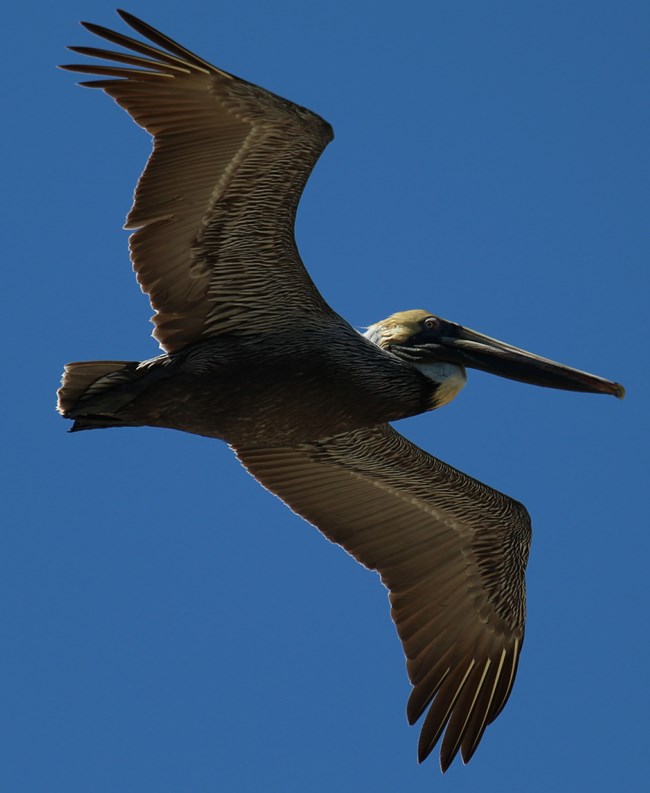
NPS There are two species of pelicans in Florida, the more common brown pelican, which is a year-round resident, and the migratory American white pelican that spends its winters in Florida and the rest of its time in the northern states and Canada. Their common names describe them pretty accurately, and if seen side by side it would be hard to confuse them, though the brown pelican does have a good bit of white on its head and neck to go along with its grayish-brown body. They can grow upwards of 50 inches in length, weigh around nine pounds, and sport an impressive seven foot wingspan. Their most distinctive anatomical feature is doubtless the pouch which hangs below their long, lower bill. These elastic pouches can hold up to three gallons of water- three times as much liquid as can be contained in their stomachs! The ability to hold so much water at one time comes into play when it’s time for the pelican to catch its main food source- fish. Pelicans require up to four pounds of fish (and perhaps some shrimp) per day to survive. So as they are flying at up to 70 feet high above the ocean, with their long necks folded backwards and their heads resting on their backs, their keen eyes are looking below for schools or even single fish in the water below. When they spot a likely meal, they dive straight down on their unsuspecting quarry and use their pouches to gather up as many fish as they can, along with a large amount of water. However, the water is squeezed out of their mouths, and the trapped fish are then swallowed. If the fish are not located right at the surface of the water, no problem, as pelicans are strong swimmers and can dive as deep as 30 feet. Striking the water at great speeds, as well as surfacing from many feet below, is made possible by the existence of air sacs beneath the bird’s skin that cushions impacts and provides buoyancy. The pelican’s pouch is useful for more than just feeding. It is also used as a cooling mechanism in the heat of the summer when water evaporates off the skin surface. But its use as a feeding trough is most appreciated by young pelicans when the parents bring them back a meal to the nest! While as adults they can live up to 30 years in the wild, they reach their breeding stage at about four years of age. Gregarious creatures by nature, they nest in large colonies, sometimes located in mangrove forests, primarily during the months of March through May. The male dutifully gathers and delivers reeds, grass, straw, and sticks to the female, who takes on the chore of building the nest in intertwined branches. She subsequently lays two to three eggs, and both parents will trade off incubating them for about one month. When the chicks are born they are altricial, meaning they are blind, featherless, and completely dependent upon their parents. They develop quickly though, and typically fledge about 75 days after hatching. Not too many things in nature pose a threat to healthy, adult pelicans as long as they have access to adequate amounts of fish and nesting habitat. It was not until the late 19’th century that their population numbers began to drop, and that was because their feathers suddenly become fashion items in the millinery trade and were in great demand to decorate ladies’ hats! Additionally, many pelicans were killed by fishermen in the early 20’th century who thought that the birds were competing with them for fish. (The type of fish eaten by pelicans actually tend not to be the commercial species targeted by fishermen.) Because of these twin threats and their effect on pelican numbers, President Theodore Roosevelt set aside what would become the first National Wildlife Refuge- Pelican Island, near Vero Beach, Florida, in 1903. Though early protections for pelicans helped, widespread use of the pesticide DDT beginning in the 1940’s led to decimated pelican (and other bird) species populations by the 1960’s. (DDT causes birds’ egg shells to thin to the point where they can be crushed even by the weight of a mother bird incubating them in the nest.) Pelican numbers had dropped so low that the federal government listed them as an endangered species in danger of extinction throughout their range in 1970. DDT was banned by the Environmental Protection Agency in 1972, and consequently pelican populations began to rebound. In fact, pelicans made such a comeback that in 1985 the populations in Florida and other eastern states were removed from the federal list of threatened and endangered species. While pelicans are once again a common sight in Florida and elsewhere, they still warrant our protection. They need wild, undeveloped habitat to nest in, and unpolluted waters from which to catch fish. Discarded fishing line entangles many birds each year and subjects them to a slow and unnecessary death. But the birds are a sign of hope that when people care and act, extinction of wildlife is not inevitable, and that we can share our fast growing state with its wild creatures, including one of Florida’s best loved- the pelican. |
Last updated: March 5, 2021
